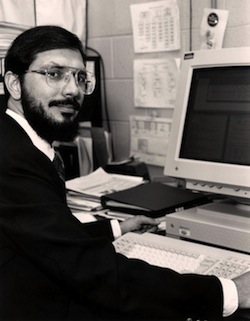Pulsar Gravitational Waves Win Nobel Prize

Image credit: Department of Energy
Russell Hulse

Image credit: Princeton University
Joseph Taylor
This year's Nobel Prize in Physics was awarded for the amazing discovery of the first indirect evidence for the existence of gravitational waves.
In 1974, Princeton University astronomers Russell A. Hulse and Joseph H. Taylor located PSR 1913+16. This object is a special type of super-dense neutron star called a pulsar. A pulsar emits beams of light that sweep through the earth's line-of-sight. As the pulsar rotates on its axis, the light sweeps across our vision, and we see the pulsar pulse. We see a radio pulse from PSR 1913+16 every 59 milliseconds. It orbits another star, which is likely another neutron star. These stars orbit each other at super-high speed every eight hours..
Four years after first discovering PSR 1913+16 and after some careful timing measurements of the pulsar, Hulse and Taylor found that the two stars move closer to each other by about three millimeters per orbit. That could only happen if something was pulling energy out of the system. But what was it?
Einstein's theory of general relativity provides the answer. It predicts that two massive objects moving around in a strong gravitational field will send gravitational waves out into space. This takes energy from their orbits, and causes them to fall closer to each other. The 8-hour orbit should be 75 microseconds shorter every year.
After 18 years of careful measurement, Taylor has now precisely timed PSR 1913+16's orbital periods and found they are within 0.3 percent of general relativity's predictions. This is strong evidence of the existence of the gravitational waves predicted by Einstein.
The pulsars won't be colliding any time soon. Although each neutron star is 7 miles in diameter and 1.4 times the mass of the Sun, they are still about a million miles apart. At their present rate, it will take 300 million years for the stars to collide. •



